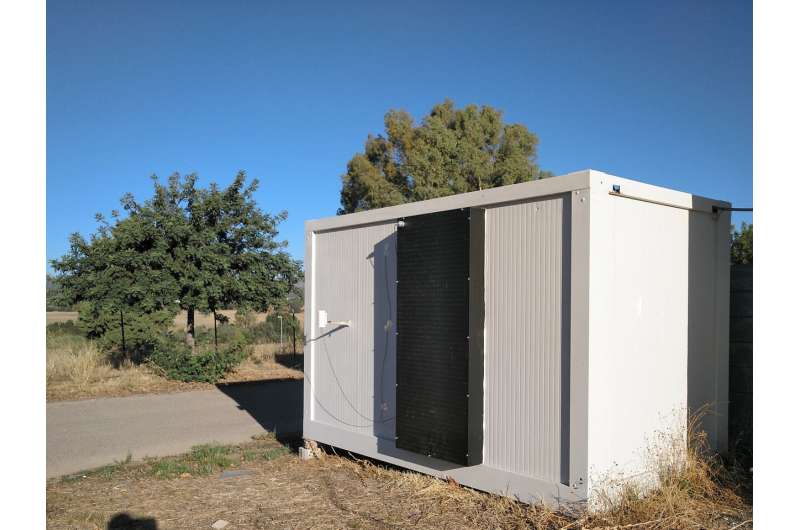The device installed by the research team. Credit: University of Córdoba
Heating and air conditioning in buildings make up almost half of the total energy consumption in the European Union. What is more, nearly 75% relies on fossil fuels, according to data from the European Commission. Hence, reducing this consumption and integrating renewable energy in heating and air conditioning processes in buildings is one of today's priorities for scientific research.
The research team from the Thermal Machines and Engines Section at the University of Cordoba performed an experimental study that validated the effectiveness of a heating system that heats air in buildings using solar radiation. The device uses a series of heat collectors, known as UTCs (unglazed transpired collectors), that absorb the heat generated in the outer layer of the facade when hit with sun rays. Later, using this energy, the ventilation air is preheated before going into the residences to heat them.
The system, patented decades ago, "has not had widespread use in Europe, other than a few experimental buildings," explains the lead author, Fernando Peci. The team installed the device on a test module of 4 x 2 meters subjected to the normal conditions of a home. Over the course of a month, during winter, this heat collector was monitored throughout different weather conditions such as solar radiation, room temperature, wind and solar radiation angle of impact.
According to the study's results, the heating demands needed to heat the building would be covered for 75% of the days accounted for in the study, proving that "this technology could offer great performance in order to heat buildings using solar energy," especially those without much glass on their facades and facing southwards, as the Northern Hemisphere receives more natural light during the day from that direction.
A strategy to refurbish buildings:
As the lead author of the research points out, this heating system could be advisable when renovating old buildings, since installing it does not alter the original facade. The heat collector is made up of a perforated metal plate, covered with a dark material, so it can connect to the ventilators and carry the heat inside, so the building would be minorly affected.
Furthermore, as Fernando Peci underscores, the team suggests using these ventilation systems in social housing, "in homes where most families can't afford to pay for heating costs." In this vein, the device would not only benefit the environment, but also translate into financial savings on the electricity bill, one of the most feared bills in the winter.
More information: Fernando Peci et al, Experimental study of a modular Unglazed transpired collector Façade for building refurbishment, Solar Energy (2020). DOI: 10.1016/j.solener.2020.02.103
Journal information: Solar Energy
Provided by University of Córdoba
























